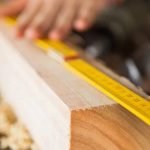Woodworking is a craft that requires precision, skill, and attention to detail. One crucial factor that can greatly impact the outcome of woodworking projects is the moisture content of the wood being used.
The question of “how dry should wood be for woodworking” is one that every woodworker must consider to ensure successful results. The level of moisture in the wood can affect its stability, strength, and overall quality, making it essential to use properly dried wood for any woodworking endeavor.
Understanding the moisture content in wood is key to achieving desired results in woodworking. Wood naturally contains water, and this moisture level can vary depending on factors such as species, location, and processing methods. Excess moisture in wood can lead to warping, cracking, or glue failure, while overly dry wood may result in difficulty during shaping or joinery. Therefore, finding the right balance of moisture content is critical for a successful woodworking project.
The impact of moisture content on woodworking projects extends beyond just the immediate results. Using improperly dried wood not only affects the final appearance and structure of a piece but can also result in long-term issues such as joint failures or instability. To avoid these pitfalls, it is important to understand how different drying methods like air drying and kiln drying influence the moisture content of wood and how to test and maintain appropriate levels for specific woodworking tasks.
Understanding the Moisture Content in Wood
When it comes to woodworking, understanding the moisture content in wood is crucial to the success of any project. The moisture content of wood refers to the amount of water present in the wood fibers, which can significantly impact its workability and quality. Wood that is too wet or too dry can lead to problems such as warping, cracking, and splitting, making it essential for woodworkers to pay close attention to this factor.
The ideal moisture content for woodworking projects typically ranges from 6% to 8% for indoor projects and 12% to 14% for outdoor projects. This range ensures that the wood is stable and less likely to experience dimensional changes once it has been crafted into a final product. To achieve these optimal moisture levels, it is important to properly dry the wood before beginning any woodworking project.
One common method for drying wood is air drying, which involves stacking lumber outdoors in a well-ventilated area for several months to allow natural air circulation to remove excess moisture. Another method is kiln drying, where the wood is placed in a controlled environment with specific temperature and humidity levels to speed up the drying process. Both methods have their advantages and disadvantages, but ultimately aim at achieving the desired moisture content for woodworking purposes.
The Impact of Moisture Content on Woodworking Projects
Woodworking projects are greatly influenced by the moisture content present in wood. Understanding how dry should wood be for woodworking is crucial to ensure the success and longevity of your projects. The ideal moisture content level can vary depending on the type of woodworking project you are working on, as different levels of dryness are required for different applications.
When wood has a high moisture content, it is more prone to shrinking, warping, and cracking as it dries further. On the other hand, if the wood is too dry, it may become brittle and difficult to work with, leading to issues such as splintering and breakage during the woodworking process. Therefore, achieving the right balance when it comes to moisture content is essential for producing high-quality woodworking pieces.
One common method used to determine the moisture content of wood is by using a moisture meter. This tool measures the percentage of water in the wood and helps woodworkers gauge whether the material is adequately dried for their project. Additionally, some seasoned woodworkers may rely on visual cues such as checking for cracks or feeling the weight of the wood to estimate its dryness level.
Different Methods for Drying Wood
Woodworkers often face the dilemma of choosing between air drying and kiln drying methods to achieve the desired moisture content in their wood. Each method has its own advantages and disadvantages, depending on the type of woodworking project and specific requirements.
Air drying is a traditional method that involves stacking wood in a well-ventilated area for an extended period of time, allowing natural air circulation to gradually reduce the moisture content. While this method is cost-effective and environmentally friendly, it requires patience as it can take several months to years to achieve the ideal moisture content levels for woodworking projects.
On the other hand, kiln drying is a more controlled process that uses specialized equipment to quickly reduce the moisture content in wood. This method involves placing the wood in a specially designed kiln where temperature and humidity levels are carefully regulated to accelerate the drying process. Kiln drying is faster than air drying and ensures more consistent results, making it suitable for commercial woodworking operations where time is of the essence.
| Air Drying | Kiln Drying |
|---|---|
| Cost-effective | Faster process |
| Environmentally friendly | More controlled results |
Ideal Moisture Content Levels for Different Types of Woodworking Projects
Properly dried wood is essential for successful woodworking projects. The moisture content of the wood plays a significant role in the quality and longevity of the finished product. Different types of woodworking projects require varying levels of moisture content in the wood to ensure stability and durability.
Interior Furniture
For interior furniture such as tables, chairs, and cabinets, it is recommended to use wood with a moisture content between 6% to 8%. This range provides a balance between stability and workability, reducing the chances of warping, cracking, or shrinking once the furniture is completed.
Outdoor Projects
Outdoor woodworking projects like decks, fences, or garden furniture require wood with a slightly higher moisture content ranging from 12% to 16%. This higher moisture level helps the wood withstand outdoor elements like rain, humidity, and sunlight without becoming too brittle or prone to rotting.
Crafts and Small Projects
For smaller woodworking projects such as cutting boards, picture frames, or ornaments, wood with a moisture content between 8% to 10% is ideal. This range allows for easier manipulation and shaping of the wood while ensuring that the final product remains stable over time.
When determining the ideal moisture content for your woodworking project, consider factors such as the type of wood you are using, the environmental conditions where the finished piece will be placed, and the specific requirements of your design. Testing the moisture content of your wood using a moisture meter is a reliable way to ensure that you are working with properly dried wood for your project.
How to Test the Moisture Content of Wood
Woodworking projects require properly dried wood to ensure quality, durability, and stability. Understanding the moisture content of wood is crucial in achieving successful outcomes in woodworking. The moisture content refers to the amount of water present in the wood, which can significantly impact its workability and overall performance.
To determine the moisture content of wood, there are several methods that woodworkers can utilize. One common method is using a moisture meter, a handy tool designed specifically for measuring the moisture levels in wood. Moisture meters come in various types, including pin-type and pinless meters. These devices provide accurate readings that help woodworkers determine if the wood is adequately dried for their project.
In addition to using a moisture meter, there are other DIY methods for testing the moisture content of wood. One effective approach is weighing the wood before and after drying it in an oven at a specific temperature for a set period.
By calculating the weight loss during this process, woodworkers can determine the percentage of moisture present in the wood. Another method involves using simple tools like nails or screws to observe any swelling or shrinkage in the wood, indicating its moisture levels.
Common Mistakes to Avoid When Working With Improperly Dried Wood
Working with improperly dried wood can lead to a myriad of issues in woodworking projects. The moisture content of wood plays a crucial role in the final outcome of any project, affecting its stability, appearance, and overall quality. In this section, we will explore some common mistakes to avoid when working with wood that has not been adequately dried.
Avoiding Premature Cutting and Shaping
One of the most common mistakes made when working with improperly dried wood is cutting and shaping the material before it has reached the ideal moisture content. This can result in warping, cracking, and shrinking as the wood continues to dry after being cut. It is essential to allow the wood to acclimate to its surroundings and reach the appropriate moisture levels before beginning any cutting or shaping processes.
Ignoring Signs of High Moisture Content
Another mistake to avoid is ignoring visible signs of high moisture content in the wood. These may include dampness, mold growth, or a musty odor. Working with wet wood can lead to problems such as difficulty in achieving proper joinery, glue failure, and increased risk of decay over time. It is crucial to inspect your wood carefully before starting your project and address any issues related to excessive moisture content.
Rushing the Drying Process
Lastly, rushing the drying process can also lead to complications when working with wood. While it may be tempting to speed up the drying process using artificial means such as ovens or heaters, doing so can cause uneven drying and damage to the wood fibers. Patience is key when it comes to properly drying wood for woodworking projects. By allowing the wood to dry naturally at a controlled pace, you can ensure better results in your final creations.
By avoiding these common mistakes when working with improperly dried wood, you can achieve better outcomes in your woodworking projects. Paying attention to the moisture content of your materials, allowing them to acclimate properly, and taking steps to prevent excessive drying or high humidity levels will help ensure that your finished pieces are both durable and visually appealing.
Tips for Properly Storing Wood to Maintain the Desired Moisture Content
Properly storing wood is crucial in maintaining the desired moisture content for woodworking projects. Here are some tips to help you preserve the quality of your wood:
- Store wood in a dry and well-ventilated area: Moisture can easily seep into wood if it is stored in a damp environment. Make sure the storage area has good air circulation to prevent the build-up of humidity.
- Avoid direct contact with the ground: Placing wood directly on the ground can lead to moisture absorption from the soil. Use pallets or racks to elevate the wood off the floor and reduce the risk of moisture damage.
- Use stickers for proper stacking: When stacking wood, use stickers (small strips of wood) between each layer to promote air circulation. This helps prevent uneven drying and minimizes the chances of mold or mildew growth.
Maintaining the ideal moisture content in your wood will not only ensure better results in your woodworking projects but also prolong the lifespan of your materials. By following these storage tips, you can create a suitable environment for your wood to stay dry and ready for use in various projects.
Remember, using properly dried wood is essential for achieving high-quality results in woodworking. Be mindful of how you store your wood to maintain its moisture content and avoid potential issues down the line.
Conclusion
In conclusion, the moisture content of wood plays a critical role in the success of woodworking projects. Using properly dried wood is essential to prevent issues such as warping, cracking, and overall structural instability in your creations. The keyword “how dry should wood be for woodworking” is crucial to keep in mind throughout every step of your woodworking journey.
By understanding the impact of moisture content on woodworking projects and learning about the different methods for drying wood, you can ensure that your materials are at the ideal moisture level for the specific project at hand. Whether you choose air drying or kiln drying, knowing the ideal moisture content levels for different types of woodworking projects will ultimately lead to better results and a more satisfying woodworking experience.
Remember to regularly test the moisture content of your wood, avoid common mistakes related to improperly dried materials, and take proactive steps to store your wood correctly to maintain its desired moisture content. By following these guidelines and emphasizing the significance of using dry wood in your woodworking endeavors, you can set yourself up for success and create beautiful, long-lasting pieces that showcase your skills as a craftsman.
Frequently Asked Questions
How Do You Know if Wood Is Dry Enough for Woodworking?
You can determine if wood is dry enough for woodworking by checking its moisture content using a moisture meter. Ideally, the moisture content should be around 6-8% for indoor projects to prevent warping and cracking.
How Long Should Wood Dry Before Woodworking?
The amount of time wood should dry before woodworking depends on various factors such as the species of wood, thickness, and environmental conditions. In general, it’s recommended to air dry wood for at least 6-12 months before using it for projects.
What Is an Acceptable Moisture Level for Wood?
An acceptable moisture level for wood in woodworking is usually considered to be around 6-8%. This ensures that the wood is stable and won’t shrink or expand significantly once it’s been used in a project. Properly dried wood will result in better quality finished products.

Hi everyone! I’m a woodworker and blogger, and this is my woodworking blog. In my blog, I share tips and tricks for woodworkers of all skill levels, as well as project ideas that you can try yourself.





